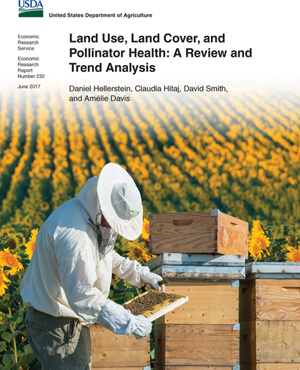
A report summary from the Economic Research Service
United States Department of Agriculture
What is the issue?
Crops that depend on pollinators account for up to one-third of total U.S. food consumption. However, honey bees and other pollinators face a variety of stressors, including diseases, insect pests, pesticide exposure, and changing landscapes. Over the last decade, annual losses of managed honey bee colonies have been high according to Land Use, Land Cover, and Pollinator Health: A Review and Trend Analysis, a new report from USDA’s Economic Research Service (ERS). Better nutrition for pollinators may help alleviate the effects of some of the stressors. Changing the Nation’s land uses and land covers (LULC) — such as by planting vegetation rich in nectar and nutritious types of pollen—may improve the forage available to pollinators. This study reviews the literature on the effects of land use on pollinator health and examines trends in pollinator forage quality as LULC has changed in the United States over the last 30 years.
What did the study find?
A review of the literature reveals that both managed honey bees and native pollinators face several sources of stress that affect colony health. The main findings include:
- Honey bee mortality, as measured by the loss of a honey bee colony, is higher than in previous decades. Annual losses varied between 29 and 45 percent of colonies from 2010-11 to 2015-16.
- Assessing the status of native pollinators is difficult because long-term population data are not available. However, evidence points to population decline for several wild bee species (notably bumblebees) and some butterflies, bats, and hummingbirds.
- A variety of stressors affect the health of honey bee colonies. Beekeepers reported that in spring 2015, nearly 45 percent of colonies were affected by varroa mites, 20 percent were affected by other pests, and 17 percent were affected by pesticides.
Beekeepers in the United States have maintained and even increased the number of colonies over the last decade through intensive management of honey bee colonies:
- Adapted practices include splitting a honey bee colony and adding a new queen to one of the splits, systematic monitoring of colonies for pests and pathogens, and supplemental feeding.
- The number of honey-producing colonies has increased by 9 percent from 2.44 million in 2007 to 2.66 million in 2015. Over the same period, the value of production of the top 10 pollinator-dependent crops grew by a weighted average of around 76 percent.
The literature review also reveals evidence of how LULCs that contain vegetation beneficial to pollinators improve both pollinator abundance and health and can lead to better agricultural outcomes. The LULC-related needs of native pollinators differ from those of managed honey bees.
- Native pollinators benefit from access to nearby high-quality forage habitat—habitat that is both rich in plants that provide pollen and nectar and that contain nesting opportunities.
- Managed honey bees are often transported from location to location by their beekeepers to provide pollination services and to increase honey production. Thus, the overall availability of forage may matter more than its exact placement. For example, the provision of high-quality forage land in the Dakotas, where many honey bee colonies spend the summer refortifying themselves, may help improve colony survival rates.
To examine how broad land-use changes have affected the ability of the land to provide forage to pollinators, ERS developed a forage suitability index (FSI) that links pollinator forage quality to LULC. Findings show that forage suitability was unchanged for most (75 percent) of the Nation between 1982 and 2012. Overall LULC changes in this timespan led to a small increase in the average FSI nationally. This is in part due to land taken out of agricultural production under USDA’s Conservation Reserve Program (CRP).
However, the overall results mask regional and temporal variation:
- From 1982 to 2002, FSI improved on about twice as many acres as it declined. But from 2002 to 2012, the index declined on more acres than it improved.
- In North and South Dakota’s summer foraging grounds, FSI declined more than the national average between 2002 and 2012. This change is driven by decreases in acres with high FSI LULCs (such as CRP) and increases in acres in low FSI LULCs (such as soybeans).
These findings are limited by the study’s focus on estimated changes in the FSI. Other factors that may affect pollinator health—such as changes in land management, including pesticide use, and changes in field size and associated densities of uncultivated field edges—are not considered.
The report concludes with a summary of economic insights on issues facing the development of markets for forage-rich pollinator habitat. Pollinator habitat has “public good” features, so markets to provide better pollinator habitat may not readily develop. This can lead to under-provision of forage-rich landscapes. For example, if a landowner converts land to honey bee-friendly habitat, his or her honey bees may benefit from this conversion but so, too, will honey bees managed by others. Thus, the landowner incurs the full cost of this conversion without reaping full benefits. Assigning exclusionary rights for hive placement—as is done in a few States— may encourage beekeepers and landowners to work together to …


